- History for Peace
- Aug 26
- 24 min read
Marking a decade since the first History for Peace conference, the annual conference 2025 took place on the theme, 'On History and Literature' in Calcutta on 24, 25 and 26 July. Speakers and participants explored where history ends and literature begins, what separates the two disciplines, what brings them together, how literature contributes to the writing of history, how history shapes the writing of literature and importantly, the value each discipline brings to our lives in these peaceless times.
Naveen Kishore’s Opening Address unsettled the tenuous boundaries we construct between fiction and nonfiction, between truth and its antonym. Drawing on a conversation between Bosnian writer Alexander Hemon and Nigerian author Teju Cole, Kishore emphasized that many languages did not carry words that would translate nonfiction. Did this mean that these languages did not have truths? On the contrary, they were brimming with stories for that was their lifeline––stories and the act of storytelling.
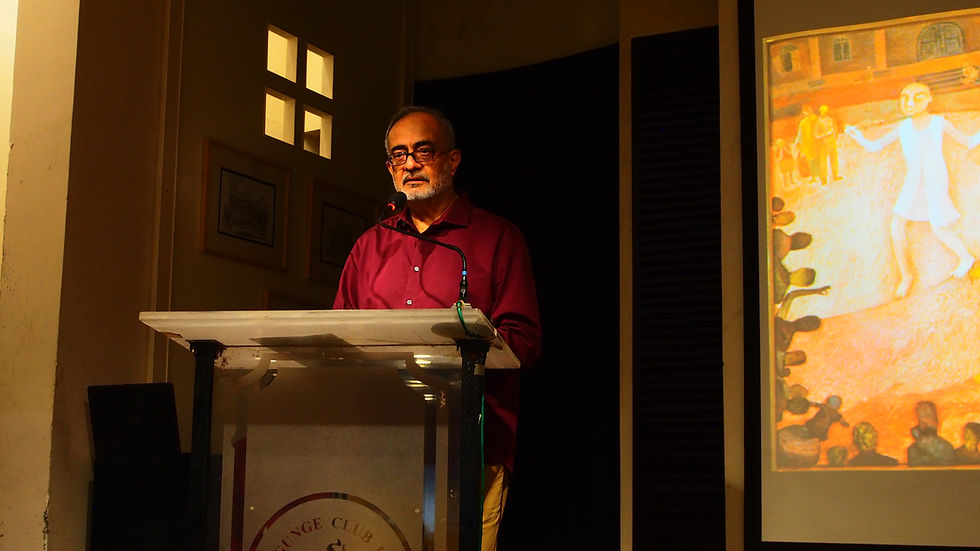
In a ‘marketplace of labels’, Kishore expressed his discomfort with getting swept by a label often ascribed at the cost of meaning; his unease bearing particular resonance in a time divided by labels of fiction and nonfiction, of widening fissures, of time turned irrational where ‘The nightmare is no longer something we dream of. It is dreamt of on our behalf.’ He convincingly argued that it is in this now-ness that ‘bearing witness’ was thrust upon us and in bearing witness we could reveal the flipside of Despair’s coin––Hope. He urged that we channel the rage that is consuming us into action; he urged that we ‘do’. Our capacity to read and deliberate would allow us to ‘sing the times’.
Standing on the edge of this night, history had not left us––it had imprinted itself on the body and the body had become the habitus of the story. Yet there were also those that vanished from our history, those whose memory was erased. What happens when memory fails to remember? Kishore left the audience and speakers with much to ponder and hope to read, deliberate, write, to translate the times or simply, ‘do.’
Meera Visvanathan commenced her address, The Historian and the Storyteller, with a nostalgic account of how stories served as her point of entry into the discipline of history. She explored the importance of stories, especially the folk tales that we hear when we are young, which impact our imagination. However, she noted that these tales are, at best, refracted images of the past with no direct relation to history.

She illustrated her argument by discussing the various iterations of ‘The Tale of Transposed Heads’ from the Vetala Panchavimshati. A tantric approaches King Vikramaditya, ordering him to bring the vetala hanging upside down from a tree. The vetala is portrayed as a fearsome, malevolent spirit of the cremation ground who possesses dead bodies. When the King captures the vetala, it poses a riddle each time, which he is compelled to answer. One such riddle comes in the form of the tale of Madanasundari, the wife of Dhavala. When both her husband and brother die as a result of decapitation, she prays for their resurrection. When her wish is granted, she reattaches their heads and bodies together but in her haste the heads and bodies get switched. The riddle then presents the dilemma––who should Madanasundari choose as her husband? This serves as a captivating story about love and sacrifice but historians may only conjecture about why this riddle-tale was so captured in the vulgate collection––was it a rendition of some bawdy folklore, symbolic of women’s desires towards a man other than her husband or some moral lesson about dharma?
In the context of the Vetala Panchavimshati Visvanathan highlighted the tradition of ‘emboxment', or a story within a story, found in many classical Indian texts, and elsewhere. Later renditions of the story in Jain and Persian retellings introduce various modifications but the base plotline, or the frame story, remains the same, These retellings serve as palimpsests of the original tale, each carrying layers of cultural impact. Visvanathan stressed the importance of the hand of the storyteller who has the authority to mould the story in its own direction. Historians and storytellers are travellers in the world of narratives, though with diverse aims. Literature can serve as a point of entry into history, she argued, but it should not be mistaken for the historical reality because literature tells us a different kind of truth––one which familiarizes us with the ethics and culture of a time and place.
In the third session of the day, Professor Romila Thapar, drawing from her monumental work Shakuntala: Texts, Readings, Histories (2011) explored the multiple retellings of Shakuntala as windows into the societies that produced them. Literature and history, she noted, were once inseparable; only in the last century have historians insisted on ‘proven evidence,’ treating literary works as suggestive rather than descriptive of the past.
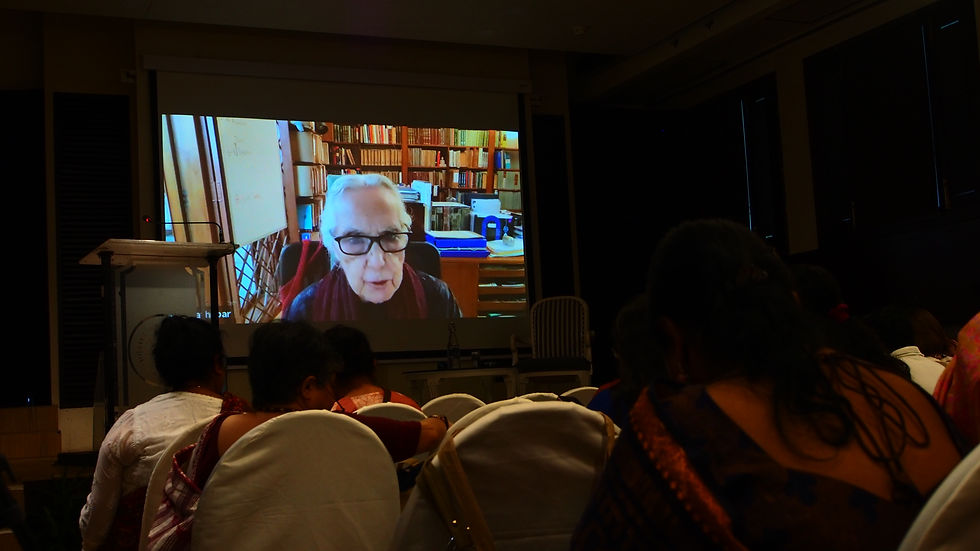
Thapar contrasted two major versions of the story of Shakuntala. In the Mahabharata, the forest ashram is a lived social space, the king arrives without pomp and caste is not foregrounded. When Shakuntala returns with-child, King Dushyant no longer recalls their union in the forest. Shakuntala, when denied, answers back sharply until a divine voice confirms her claim. This reflects an early, clan-based society where royal authority was still negotiable. Kalidasa’s Abhijnanashakuntalam, set in the Gupta ‘golden age’, shifts to a courtly world. The forest is aestheticised, the hunt a royal pastime and Shakuntala is accompanied by ashram companions who instruct her in wifely decorum. The scene of rejection is polite––she leaves quietly, her acceptance signalling the patriarchal norms of the time.
The differences are not merely artistic but historical. The Mahabharata’s version reflects an earlier, less stratified society; Kalidasa’s version represents the sophistication and patriarchal norms of the Gupta age, where Sanskrit kavya celebrated elegance, restraint, and female acquiescence. The forest itself changes meaning—from a lived social space in the epic to an aestheticised backdrop in the play. Even the hunt transforms, from a necessary act of clearing land to a royal pastime.
William Jones’s eighteenth century English translation celebrated the refined Kalidasa rendition of the tale while sidestepping its eroticism. European acclaim followed, as did nationalist-era appropriations—Raja Ravi Varma’s European-style paintings and Bengali translations by Ishwar Chandra Vidyasagar and Abanindranath Tagore, the former aligning Shakuntala with nineteenth century ideals of upper-caste womanhood.
Thapar’s reading of these Shakuntalas showed how each retelling refracts its own time—how a forest girl with a sharp tongue who was once afraid to confront a king transformed in another age into the emblem of gentle submission. She reminded the audience that the historian’s role is not to decide whether Shakuntala ‘really’ existed, but to ask what her story has meant to societies over two millennia. Literature may never be history in the evidentiary sense, but remains indispensable to the historian’s craft—because the fictions we tell about the past are often as revealing as the facts we can prove.
Krishna Kumar in his address titled Gandhi: History, Fiction, Truth began by mentioning the COVID 19 pandemic emphasizing the resurgence of Gandhian ideas at the time with regard to the blurring of the administrative distinction between cities and villages and the figure of the self-governing citizen amidst a nationwide lockdown. Hereafter, Kumar laid down the premise of his newly published book, Thank You, Gandhi, ushering Gandhi back into a pedagogical as well as a contextual relevance, one that is endangered in scholastic spaces nowadays. His book, centred around two fictional friends––one having passed away during the pandemic leaving the other a manuscript to complete, is tied together by Gandhi and his teachings at the helm.
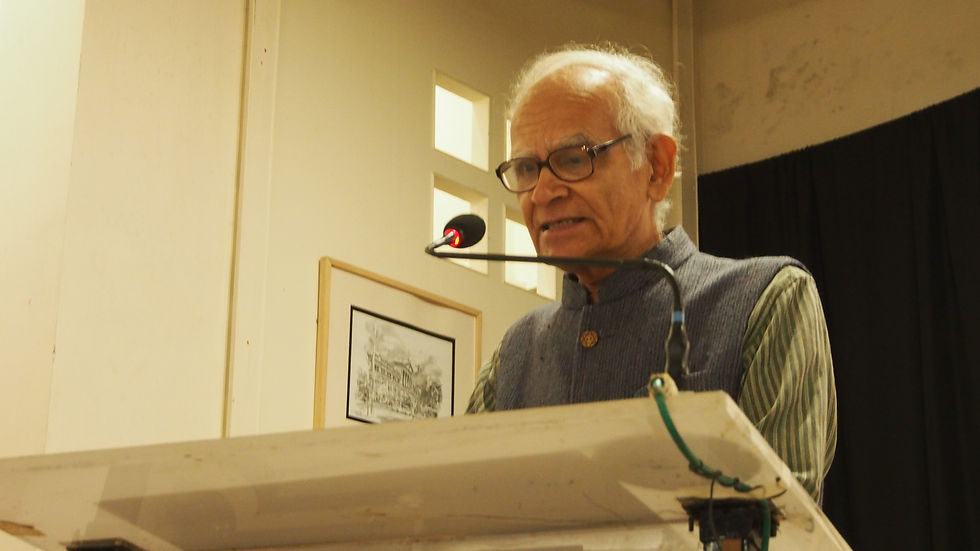
In keeping with the broader theme of the conference, Kumar grappled with the intersection of ‘History and Literature’ at two levels. The first was in his book where he attempted to straddle the worlds of fiction and nonfiction which he maintains are strongly compatible with each other. The second was through his study of Gandhi wherein he suggests that when rescued and relieved from his historical context, a significant portion of Gandhi’s life reads much like fiction. This metafictional shade of Gandhi, Kumar suggests, can be effectively utilized to aid students in understanding the past in a way that creates a safe space for truth to meaningfully interact with literature in classrooms.
In the latter half of his talk, he delves deeper into an analysis of Gandhian ideas as a dynamic entity, constantly being moulded by its political context. According to Kumar, Gandhi’s political pamphlet, Hind Swaraj, if read independent of its footnotes, is a theoretically nebulous piece of extremist writing exuding anger but lacking articulation. Only after Gandhi’s interaction with Gopal Krishna Gokhale does his rage turn into patient argument crystallizing his central ideal of satyagraha or passive resistance by championing non-violence. According to Gandhi, there is a cyclical relationship between violence, fear and truth. Violence manufactures fear among the masses, leading them astray from seeking the truth. Therefore, he suggests that to pursue truth under the State, there needs to be a formal framework of safety which protects the citizen. At the end of his talk, Krishna Kumar invited us to problematize Gandhi instead of deifying him, to treat him as a figure of literary criticism and to make him accessible as a subject of dialogue in schools, colleges and life again.
Kavita Panjabi’s talk centred on the importance of aesthetics and subjective affect in the making of what we know to be history. Opening with the example of the legend of the queen of Jhansi, Panjabi charted a thread of historical development— the oral narratives of Jhansi ki Raani among the people of Bundelkhand made their way into popular Hindi literature, and the tale of the queen’s bravery in the face of colonial violence went on to inspire a generation of Indian nationalism. It may not always be possible to discern the exact details of what is true and what is embellishment but Panjabi argued that that which transforms history cannot but be part of the truth. To that end, the aesthetic impact of the stories told, art created and events witnessed plays a major role in memorialising even the ‘factual’ dimensions of history.

Through the affect generated in aesthetic experience, the ‘dead facts’ of history—its cold, intellectual knowledge—are interpreted individually and personally, and subjective understandings of concepts like famine, violence, and grief develop. Referencing interviews with women who participated in the sharecroppers’ Tebhaga movement in 1946 in Bengal, Panjabi said the roots of their participation overwhelmingly lay in an aesthetic, affective experience of witnessing the impact of the Bengal famine of 1943. Urban women witnessed starving rural women stream into the streets with emaciated, or even dead, children on their hips, begging for some rice water as relief. The impact of witnessing and interacting with such extreme hunger, rather than any intellectual knowledge of the numbers or facts of the famine, motivated the women of Bengal towards a lifetime of engagement with subsequent historical movements, irrevocably influencing the trajectory of history in the region and the nation. While aesthetics have often been reduced exclusively to the question of ‘beauty’ and relegated to the domain of detached art, Panjabi’s talk called for increased attention to how aesthetics are a crucial, everyday feature of our present and a significant element in our knowledge of the past.
On the second day of the conference, Avinash Kumar’s address, Narrating the Nation: Literature as Archive, Allegory and Antagonist in Historical Understanding put forth a compelling argument about how literature can pose a counter-narrative to history. He started by quoting Hayden White who argued that objective history is an illusion, because history is ultimately a story narrated by a storyteller.

Kumar’s discussion of the literature produced during the French, Russian and Industrial revolutions show how these texts recount completely contrasting images of the time. He quoted Lucien Febvre, who believed that history writing should include a strong recognition of people’s emotions, something which literature excels at. He further expanded his argument drawing on how literature allows us to think about history from a different lens, and serves as more than just as a supplementary tool. Literature and history form a terrain for the battle of narratives, and literature is consciously and constantly utilized for writing history.
Kumar then moved on to a brief literary history of Hindi literature in India. He showed how writers like Ramchandra Shukla and Kishori Lal Goswami constructed a ‘history’ for Hindi dating back hundreds of years. Through these writers, he stressed on the changing legacy of a language coherent with the popular rhetoric of the time. Literature, he argued, is often used as a political tool to legitimize a particular belief and hence, should be read with this in mind. Knowing then the role literature plays in the birth of an idea with the power to galvanize people, and the power to change, through the writer’s pen, he offered pertinent reflections on the following questions––how do we reimagine our communities? Who constitutes a nation in literature? A nation is narrated in a body of literature and the ‘who’ constantly re-negotiated. Therefore, literature is not only an archive for the historian but a powerful allegory of the state/nation/people and can not only complement historical understanding but also often offer contradictory view-points.
Veio Pou in his talk, ‘Writing Community Memory: Reading History through Literature’ reflected on the importance of storytelling and the act of listening intentionally. He spoke about his personal lack of learning about the country’s greatness and his struggles to find mentions of his community in readings and syllabi across curricula. Even what is included today is a mere token presence. Therefore, it is only when he embarked onto the path of research that he realized he must turn his lens inward. This culminated in his first novel, Waiting for the Dust to Settle (2020) where he took it upon himself to ‘write community memory.’
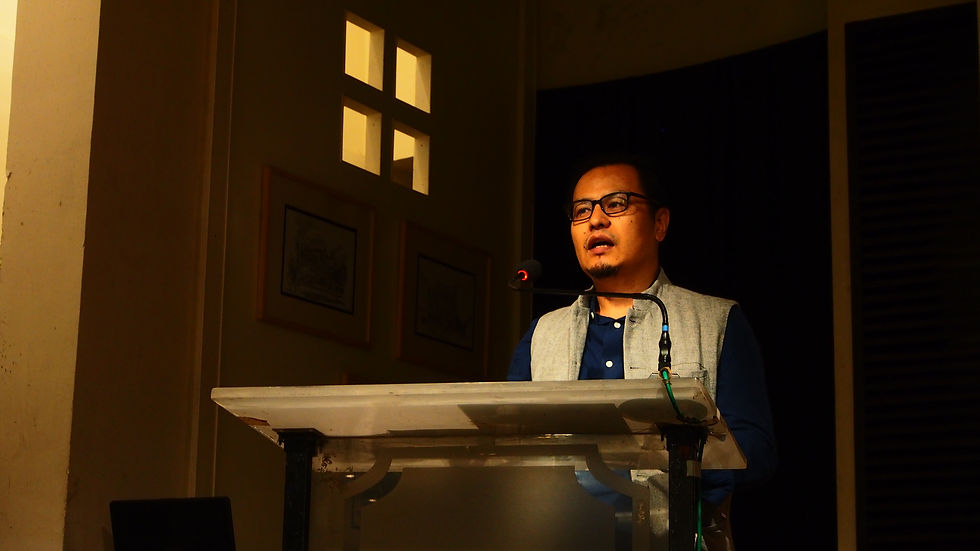
For Pou, writing community memory is to tell the story of a people using memory as the resource for weaving community experiences together. For communities like the Nagas, memorialization is the fulcrum of identity. At the same time, he acknowledges that all memorialization is selective and the decision to memorialize one thing and not the other also makes it a site of conflict. The other aspect is sustaining memory––collective memory has to be sustained and responds to legitimizing/de-legitimizing efforts by the state or the community.
Veio Pou dwells on the impact of the three-month-long Operation Bluebird of 1987, the counter-insurgency operation launched by the Assam Rifles following the Oinam incident. AFSPA was in place then, so little judicial recourse could be taken against the mass rape, killing and slew of human rights violations. Albeit nearly erased by the state and expunged from records, the trauma haunts the community. It is this haunting memory that Pou reconstructs and he lets that memory resonate, drawing attention to the multiple fissures like the conflicts between Nagas and strife amidst ethnic communities. He not only wants to draw attention to injustice to the Nagas but reflect on the internecine conflict between the Nagas themselves.
Writing community memory is a way to move beyond boxes of confinement. The Northeast is either characterized as exotic or a conflict zone allowing little else to permeate the narrative. However, in allowing the memory to speak and in storytelling with the intent to forgive and listen a healing process ensues, which is so necessary in times like this, times plagued by uncertainty.
Rakhshanda Jalil explored the tensions that arise between subjectivity and objectivity on the terrain of conflict-ridden traumatic events such as the Partition of 1947, Jallianwala Bagh, the Bangladesh Liberation War and others. The central focus of her talk was to understand how literary genres which have been born as a reaction to historical events represent the same. She draws examples from her own edited anthologies and makes it clear that the peg that she hangs her work on is diversity and not necessarily reliability or authenticity. Jalil cites the case of Urdu short stories and the Progressive Writers’ Association, where she mentions four pioneering names: Saadat Hasan Manto, Ismat Chughtai, Rajinder Singh Bedi and Krishan Chander. In this regard, she mentions how in the case of Partition, the short stories would have to end with a‘sting’; that there was no leisurely, stream-of-consciousness writing at play. The stories were undoubtedly influenced by the bunawat or weaving of writers such as O' Henry and Guy de Maupassant but had their own distinct measured style. Furthermore, she adds that often the Urdu poet was also the public intellectual, always with their finger to the pulse, reacting instinctively to the events without any evident censored cushioning.

Jallianwala Bagh, she regards, was a watershed moment in Indian literary history where the literature influenced by it spanned across different geographies in the wake of a ‘nation-wide’ tragedy albeit in the absence of a nation as such. Another example she brings forward is Chandradhar Sharma Guleri’s Hindi short story ‘Usne Kaha Tha’, published in 1915 about a Punjabi soldier fighting in the Great War or the First World War for the British Empire. Jalil is particularly fascinated by the multiplicity of details that Guleri brings forward about life in the trenches at a time where eye-witness accounts about the battles at Gallipoli or the Sinai Peninsula were inaccessible to the layman writing in India. In the case of English writing, she cites Mulk Raj Anand’s widely acclaimed novel Across the Black Waters, published in 1939, set in Europe during the War.
Jalil’s attempts to present a glimpse into the wide spectrum of representations and voices that she aims to capture with all her anthologies. She mentions how she poses multiple questions, not necessarily in the search of an answer but for the sake of asking the question itself. The question becomes the means and the end. Another liberty that the creative writer enjoys is to dwell on ‘what if’ moments which she claims is essential. Historians do not engage with hypothetical possibilities but literature does, it takes an event and juggles with the variables in order to reveal the contours of human nature often using metaphors and the guise of a love story to obfuscate the real magnitude of the event. She mentions two stories from her work which uses the premise of a romance in the wake of war; one is Faiz Ahmed Faiz’s ‘Dhaka se Wapsi Par’ and the other is Razia Faseeh Ahmad’s ‘Sadiyon ki Zanjeer’. Jalil discussed silence as a literary device––can silence heal? Can silence be used effectively to come to terms with traumatic events? These were some of the questions she posed which works by Urvashi Butalia, Ritu Menon and Kamla Bhasin address in great detail. Empathy, for Jalil, is at the core of the intersection of History and Literature––the central congruence. To use Manto’s ‘Toba Tek Singh’ as an analogy, Literature and History are not the two sides behind barbed wire fences, rather it is the liminal space between them––where edges are blurred and the desire to categorize is disturbed––the space where Toba Tek Singh lies, the space where humanity lies.
In a stirring talk, Sarmistha Dutta Gupta drew from the testimonials from families who had borne the toll of the Jallianwala Bagh massacre to trace the gaps and voices left unheard in official histories of the incident. Using poems, letters, songs and interviews, Dutta Gupta placed literary and oral testimonies alongside state records to recover what had been left out and hone her focus on histories of ‘survival’ rather than ‘martyrdom.’
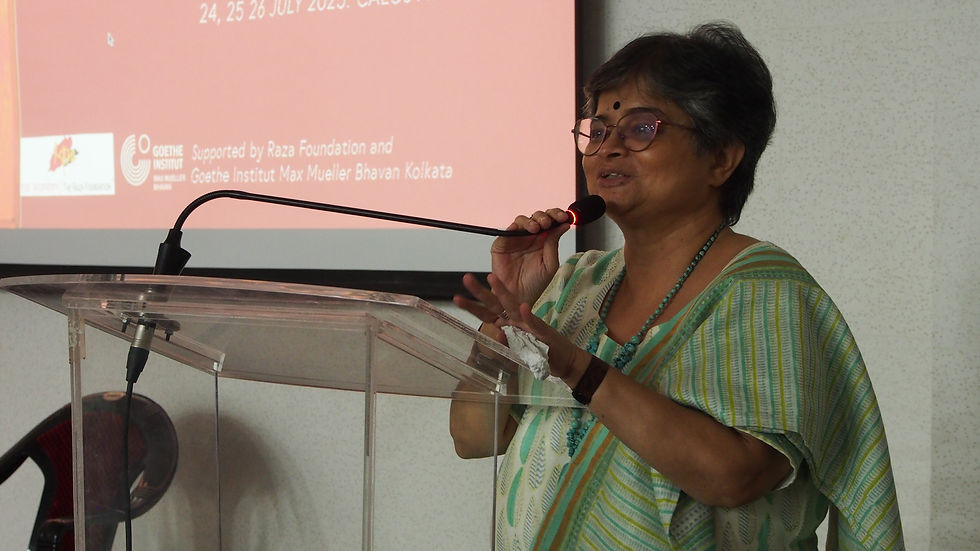
Dutta Gupta observed that official archives—colonial or modern—rarely preserve dissent. Nanak Singh’s banned 1919 poem ‘Khuni Vaisakhi’ was one such voice, suppressed under Punjab’s wartime censorship. In such times, grief and protest often survive through folk songs, letters, or oral accounts—sources still undervalued in conventional history. Her own research began with a 2016 visit to the Jallianwala Bagh memorial, when amid the tourist bustle, she was struck by how far public memory had drifted from the event’s significance. Years in the archives revealed three key erasures: the massacre’s disconnection from the First World War and Michael O’Dwyer’s coercive regime; the invisibility of women, whose survival struggles remain unrecorded; and the silence around the united resistance of Hindus, Muslims, and Sikhs.
Recovering these histories, she argued, requires expanding the source base––not just literature and archives, but songs, visual art, films, and oral histories. She cited folk songs by Punjabi women during the war—laments over separation, police harassment and hunger, with no romanticising of ‘war heroes.’ These, she suggested, blur the line between song and testimony. The talk also revisited Rabindranath Tagore’s consistent critique of the war, often overshadowed by the single act of renouncing his knighthood. His opposition to building a memorial column at Jallianwala Bagh, she noted, stemmed from rejecting colonial forms of glorification and urging mobilization against war and state violence instead. Her 2020 Victoria Memorial installation embodied this expanded memory work: First World War rifle replicas lining a corridor, an undivided map of Punjab underfoot—provoking visitors to connect war, partition, and massacre. She also drew on Manto’s short story ‘Tamasha,’ along with family photographs and oral testimonies, to restore ‘unseen faces and unheard voices.’
In her talk, ‘Exploring Literary Perspectives and Historical Contexts: Manto, Orwell, Kafka’ Rosy Singh drew attention to the intersections between history and literature by focussing on three literary works and their historical contexts. She began by asking the question––why do history or literature matter? In the eyes of Plato, none have any value to the state. Indeed Plato warns against the words of poets that sway you into lies. It is then prudent to ask why the modern nation-state clings to these disciplines. Singh briefly explains how the two disciplines are different, how literature is not bound by sources and a chronological mode of presentation and how literature does aid nation-making but there is also such a thing as literature for literature’s sake. Her discussions of the works of Manto, Orwell and Kafka, particularly their fictional and autobiographical works explored not only what they wrote but also why they wrote.

Singh recollects the story of ‘Thanda Gosht’ from his collection, Black Margins. She explains how the horrors of rape, plunder and carnage was not peculiar to the story but captured vividly the reality of Partition violence. This was the first afsaana published after Manto’s move from Bombay to Lahore. She insisted that re-telling the story, at that moment in time, to the audience, too was a mode of interpretation. The story chronicles the protagonist’s plunder of a home and his decision to ravish a young girl who he realises only later was dead––he lay on top of cold flesh. This led the protagonist to lose his virility. However, this loss of virility and his admission of the act to Kulwant Kaur, he seemingly recovered his humanity in his dying breath. Despite the legal trouble Manto found himself in, after the publication of this story and Faiz Ahmad Faiz’s testimony that this was indeed not what the Progressive Writer’s Association considered ‘literature’, Singh emphasizes the power the story holds––the human story is at the forefront; historical context is the background. Roy Harris even called it a work of ‘superior historical consciousness’ for its ability to capture the pulse of the times in a way where even the diligence of a professional historian may fail.
Singh explained how George Orwell’s Animal Farm took on the same mode, in fact it claimed itself to be a fairytale but Orwell’s use of the genre was indeed to satirize Soviet Russia where one bloody revolution brought in a new form of totalitarianism. Orwell’s novel was a satire and critique where the historical context did not have to be spelt out. Many literateurs have tried to group authors like Manto and Franz Kafka together, explaining that they belong to minority communities and express the minority’s concerns but Singh disagrees––she calls them secular writers. In their stories, human dignity is at the forefront. Even in Kafka’s diaries, which he did not want published, Singh explains how the limits of language, the links between language and religion along with memory are explored. History is a looming presence in the diary––without history, Kafka’s pain, his unease, his reflections would have no being. Whilst Singh maintains that there is a distinction between these disciplines, a distinction which cannot simply be collapsed, she argues that the disciplines complement and sustain each other.
Omair Ahmad in his talk highlighted the historiographical invisibilization of small towns in India through a deeply personal account of his hometown of Gorakhpur which he located in a broader historical context of the 1800s and 1900s. Ahmad, trained as a political scientist, began his speech with a remark as to how politics is inherently an act of imagination coupled with necessities of logic and effectiveness. Having worked abroad, he realized that often his fellow colleagues would fail to grasp nuances that plagued Indian issues on the whole. Their approach was to identify the binaries––who was the ‘good guy’ and who was the ‘bad’. Realizing this lack of a nuanced understanding, Ahmad began to look into how breakdowns of law and order impacted citizenship in the long term, an aspect that no policy paper could effectively capture and hence, he turned to personal stories and fiction.

Hailing from what he called the worst governed parts of the worst governed state in India, he grappled with conundrums surrounding identity, selfhood and belonging. Ahmad decided to then acknowledge the ‘lottery of one’s birth’ and turn it into a micro study of a region and its people. His talk was peppered with the names of certain widely acclaimed personalities who carry with them a latent Gorakhpuri legacy, one of them being Munshi Premchand. He mentions how although Premchand might not have claimed Gorakhpur but Gorakhpur claims him. A belonging no matter how transient is still reflected in the history of the small town.
He then goes on to narrate a family history and anecdote about Mohammad Ismail, his great grandfather’s eldest brother. An anglicized lawyer trained in London, acquainted with Liaquat Ali Khan, Mohammad Ismail went on to become the Pakistani ambassador to India while being an Indian citizen. What Ahmad wished to exemplify through this story was how figures of such stature like Mohammad Ismail were also products of Gorakhpur and how these cannot be classified as simplistic aberrations but have to be thought about through a more nuanced and historically informed lens. A call to step beyond our past, transgressing it through the avenue of imagination is what Omair Ahmad constantly underlined in his talk. To be informed about one’s history is not synonymous with establishing peace; for Ahmad, the representation of the margins is what is imperative for a holistic understanding and the development of a well-rounded historical consciousness.
Ending with another anecdote about his field visit to a lower-caste village in the fringes of Lucknow, he realized how spatial distinctions of the private and the public manifest for the marginalized. Since public space for them has always been a space of exclusion and erasure, any sort of representation of their community, no matter how problematic it might seem to the eye of the outsider, is one that, he claims, frees their aspirations. With this anecdote in mind, Omair Ahmad concluded his moving talk with a singular question, ‘How do we imagine a peace which is meaningful to all?
Parvati Sharma delivered an invigorating talk on the relationship between the possessor of knowledge and those who claim to know the ‘absolute truth.’ She reflected on the question––Is History no longer the exclusive domain of historians? Objectivity once gave the discipline of history its modern outlook, granting historians a sense of authority over the subject. But to what extent can we assert that one person’s truth is the ‘real’ story?

Sharma critically examined this unbridgeable gap between a scholar and a layperson––how does the former prove their authenticity to the latter? A scholar’s arguments grounded in years of study and training can be countered just as easily by a layman who enjoys a sufficient ‘following’ in this era of rising misinformation. She illustrated this with an example of the recent movie Chhaava (2025) which opens with a scholarly disclaimer urging viewers to think critically and consult multiple sources before believing what is being shown and yet, the film itself mines sources selectively leading to a narrative that is nothing short of bigotry.
Drawing on her own work on Jahangir, Sharma discussed how every written account of him forms part of a larger narrative and must be read with extreme vigilance, as each author brings with their story, their own motivations and intentions. Often the lines between interpretation and propaganda get so blurred that history becomes a battleground.
She encouraged every writer to be skeptical, know the weight their words carry and be courageous enough to ask oneself this question. Stories hide dragons of their own and what writers and historians do alike is offer approximations of the truth.
Kavita Panjabi began her conversation with Parvati Sharma narrating an incident––the death of a Palestinian poet. A lot of people came together to honour his memory and when a Palestinian woman was asked about this incident, she simply replied that when a poet dies, the life within you dies.
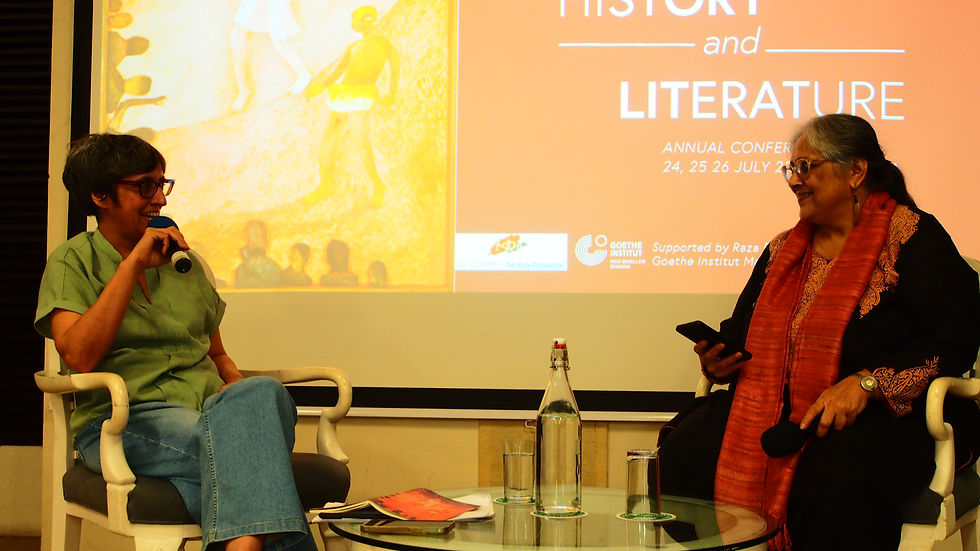
Sharma and Panjabi then discussed the impact of stories in an individual’s life because the stories we hear and tell change us in transformative ways. They further discussed the rhetoric surrounding the stories of Partition. Partition stories are being retrieved and disseminated to serve a particular narrative that is popular today. Sharma also built upon her talk, discussing how writing someone’s biography is like playing a violin with the notes in front of them. This inevitably means that even with all the information, one can spur a completely different narrative about someone. They concluded that it is impossible to see history from the lens of the present because that runs the risk of misinterpreting the past. And yet, history and literature today, more than ever, are being used as political tools to justify certain popular narratives without understanding and examining the complicated relationship between them.
After the concluding conversation between Kavita Panjabi and Parvati Sharma, participants proceeded to the three parallel workshops designed to put to practice some of the ideas discussed in the conference.
Workshops
How can we use regional literature as a historical source? Do they give us an objective account of the past? How should we make sense of literary texts which narrate stories about the past in retrospect? Is literature a subterfuge for the events of the past? These were some questions that participants of the workshop ‘Our Languages Our Pasts: Exploring History through Regional Literature’ facilitated by Sunita Biswas were challenged to engage with.
Biswas began the workshop by showing translations of the word ‘history’ into several European languages, all of which overlapped with the word ‘story’. History, in ancient Greek translated to investigation by a ‘histor’––someone who knew the craft. History and literature have several points of confluence, Biswas argued and yet, they have fundamentally different aims. Biswas focused on regional literature of Eastern India wherein participants had to read excerpts from three stories translated into English from Orissa, West Bengal and Assam.

The first was Fakir Mohan Senapati’s Six Acres and a Third. After reading selected excerpts of the novel participants were asked to go back to the period in which the story is set and to list the following––What you know, what you want to know, and what you have learnt. This led to a lively discussion about what the participants could gauge from the story and what more they wanted to know. The story––set in the backdrop of nineteenth century colonial India––grapples with the questions of social inequality in the life of rural peasants and centres around a court case.
The second story was a translation of Bibhutibhushan Bandopadhyay’s Ashani Sanket, translated as ‘Distant Thunder’ which takes place during the Bengal famine of 1943. The participants first discussed the history of the Bengal famine. Then, they moved onto the fictional aspects of the text. The context, perspective and bias in the narration of the painful story was discussed. What was shocking however, was how the themes of casteism, poverty and exploitation remain much the same even today. Literature, in a way, freezes certain events in time and allows people to read it from a humane perspective.
The final story was Anuradha Sharma Pujari’s Surrender which takes place in the backdrop of the Assam agitation and its corresponding ULFA movement. This story tells us about a surrendered militant who wants to leave the violence behind him for his wife and daughter and yet struggles to break free of the movement and to find his place in society, finally losing the battle and his life. The participants were encouraged to enter into a critical discourse after reading excerpts from all these texts. Their aim was to try and derive ways of arriving at an avenue where literature and history share a symbiotic relationship while maintaining a distance in the knowledge they perpetuate.
Debarati Bagchi, Anwesha Sengupta and Samata Biswas in their workshop ‘Reading Partition in School Classrooms: Possible Dialogues between History and Literature’ facilitated an engagement with Partition scholarship and literature in a manner which reflected the diverse, heterogeneous experiences of various communities. The workshop began with the three facilitators performing a dramatic dialogue based on two sources of the Partition––the first being Rajinder Singh Bedi’s story ‘Lajwanti’ based on the experience of an abducted woman and the second source was the Abducted Persons (Recovery and Restoration) Act of 1949 passed in accordance with both the governments of India and Pakistan. The dialogue married these two sources; one falling under the ambit of literature and the other being a legal statute to exemplify how various sources can and should be judiciously employed while teaching the Partition.

Following their skit, there was a discussion regarding the importance of using alternative modes of historiography for the Partition such as oral narratives. A few of the limitations were laid out by the facilitators––the role of memory and the ability it has to create a space for the (de)construction of history. Memory as a tool is integral in reclaiming agency, especially in the ambit of feminist discourse. The default social norm of silence is broken through the employment of a subversive and liberating speech but this recounting is also a complex phenomenon. Memories are not a homogenous whole, they are highly defined and differentiated by their contextual milieus.
The participants were divided into three groups and were supplied with a number of primary and secondary sources related to various aspects of the Partition. One group was given Saadat Hasan Manto’s short story ‘Khol Do’. The second group were provided with the complete details of the Abducted Persons (Recovery and Restoration) Act of 1949 and the third group was given resources surrounding the division of assets predominantly between West Bengal and East Pakistan, now Bangladesh. Our task was to read through and come up with a similar skit or dialogue and present it in a nuanced and sensitive manner. This particular workshop had significant student participation. In popular discourse regarding Partition, the idea of brazen communal violence takes center stage, almost invisibilizing accounts of class and caste struggles in the wake of a religious frenzy and neglecting a more banal reality that resulted due to the riots and the mass migrations that took place. This workshop was successful in highlighting how the violence materialized on ground and crept into the crevices of everyday life of a layman.
Oindrila Gooptu in the workshop Between History and Literature: Opportunities and Dilemmas explored along with the participants how literature is introduced in classrooms. The workshop initially explored the affective ties forged by literature, how literature could be galvanized into a powerful tool to sway emotions––joy, laughter, rage, revenge, even hatred. The workshop began with a discussion about how literature could spark the embers of such emotions and whether we stopped to think about the veracity of this literature, its truth claim, the consequences. Did it at all matter? Was all reading for leisure? What happens when literature is selectively used to provoke?
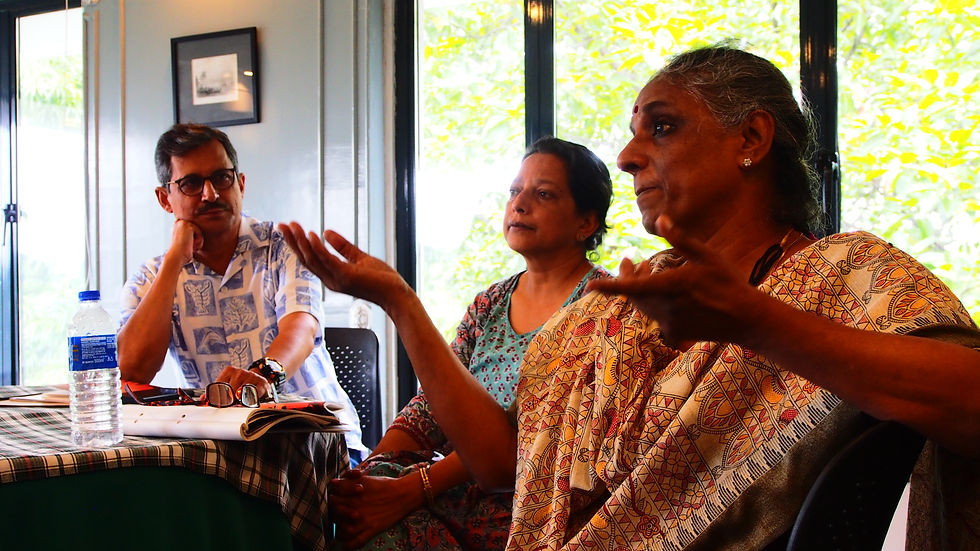
This discussion was followed by a sharing by the participants on how they interacted with literature in classrooms. One participant shared how counterfactual literature like Philip K. Dick’s The Man in the High Castle––which imagined a world after the Second World War where the Axis Powers won––made for a very thought-provoking class discussion. Another participant shared their use of literature to read the French Revolution or to grasp at Romanticism in the throes of the Industrial Revolution. Literature allowed the students to sense the zeitgeist, feel history as compared to reading history.
The last activity asked participants to read literature and discuss its place in the history classroom. This included the Dhajavihetha Jataka (on fake ascetics), an excerpt from the Baburnama, Manto’s ‘Toba Tek Singh’, an excerpt from Daya Pawar’s Baluta, Bertolt Brecht’s ‘The Children’s Crusade’ and an excerpt from Ruchir Joshi’s Great Eastern Hotel. Participants shared not only what they felt when they read the piece but also reflected on why their authors sought to memorialize this emotion, and the different techniques they employed to do so––choice of vocabulary, figures of speech, rhyme and metre etc. Participants explored how literature lent a voice to those forgotten in history, and how the discipline of history had the tricky task of evaluating literature as a source.
Reports by Aishani Mishra, Geetanjali Roy, Ishita Bhandari, Kumudini Chowdhury, Mayukhi Ghosh and Sunita Biswas. Pictures courtesy: Aishani Mishra.








Comments